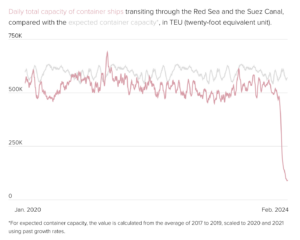The continued Houthi rebel attacks on international shipping in the Red Sea and the Gulf of Aden are costing the world significant amounts of time and money.
The attacks have forced many maritime transport companies to reroute their ships around the African continent rather than using the shorter route through the Suez Canal. Rerouting ships around Africa’s Cape of Good Hope has added 3,500 nautical miles to the shipping route between Asia and the West. The use of the longer shipping route due to the Iranian-backed rebel attacks has drastically increased the cost of transporting goods.
Accounting for about 10 percent of the volume of global maritime trade, the Suez Canal and the Red Sea shipping route is arguably one of the most important in the world. Raw minerals, oil, liquified natural gas, grains, rice, and electronic goods have moved via ship through the region without incident for decades. However, when the Iran-backed Houthi rebels of Yemen began attacking shipping after Israel launched a military campaign against Hamas, traffic through the Suez Canal collapsed.
The longer Africa route and increased time at sea have driven up fuel costs for maritime shipping companies — as well as expenses for crew and maintenance. This has led to a drastic rise in container costs for those looking to move goods around the world. In January 2023, the average cost of a standard 40-foot (FEU), non-refrigerated container was around $1,759.93. Today, the price of a container has jumped up to $5,495.20 on average.
In January of this year, President Joe Biden announced the US and UK militaries would begin an air campaign against Yemen’s Houthis in an effort to put an end to the attacks. Additionally, the two nations have dispatched naval forces to the Red Sea and the Gulf of Aden to deter Houthi hijacking attempts. Despite numerous strikes against Houthi targets, the costly campaign has thus far failed. The Houthi rebels successfully sank a British container ship over the weekend.






















